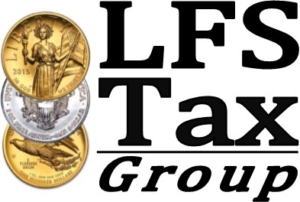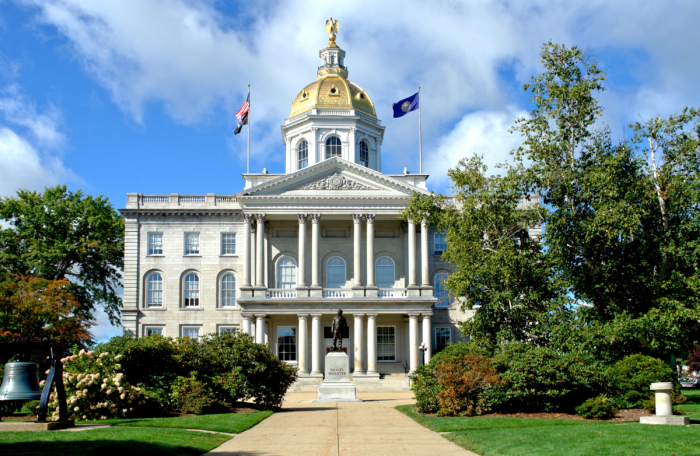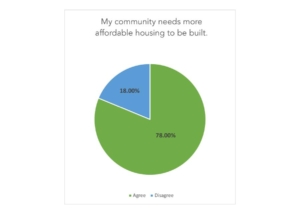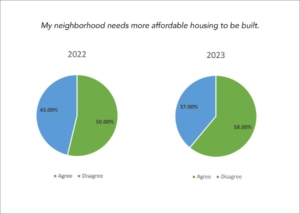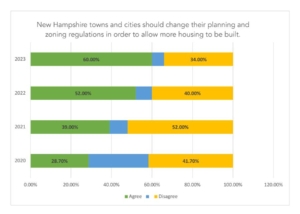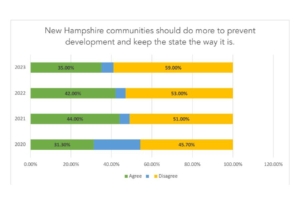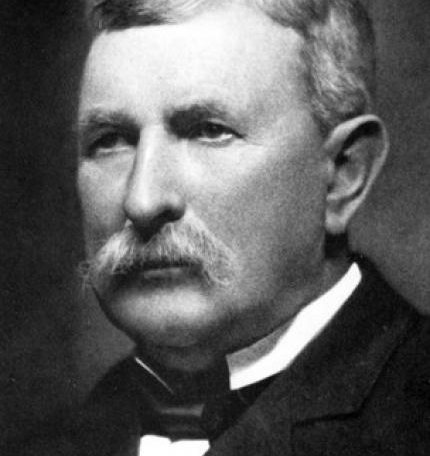Editor’s note: Since the COVID-19 pandemic, educational entrepreneurship has boomed nationwide. New Hampshire has experienced significant growth in the number of entrepreneurs and innovators willing to take on the daunting challenge of building a new educational ecosystem. This year, we’ll be highlighting some of the people and organizations that have begun expanding the education marketplace in the Granite State, as well as the obstacles they face in creating nontraditional learning environments.
Our third installment highlights Micah Studios, a low-cost learning center for kids 6–18 years old in Newport, New Hampshire, focusing on low-income families.
Newport, New Hampshire, is a relatively poor, working-class town of 6,299 in Sullivan County. Between 2017 and 2021, the median household income in Newport was $65,435 (in 2021 dollars), while the statewide average was $83,449. Meanwhile, the poverty rate in the town is 19.4%, compared to the state’s poverty rate of 7.2%.
What’s more, the town’s district public schools have been underperforming by all measures. Only 24% and 22% of students in the Newport school district are proficient in English language arts and science, respectively. Worse, just 12% of students in SAU 43 are proficient in mathematics. Compared to the performance of schools/districts throughout the state, these figures put Newport in the bottom 25%.
Given this reality, there’s a dire need for alternative education in this community. Two education entrepreneurs in Newport—Stacey Hammerlind and Jessica Rothbart—are taking steps to fill this educational void and meet the needs of local low-income families.
“There was definitely a gap and a niche that needed to be filled,” Hammerlind said.
As residents of Newport with experience in the public school setting, both Hammerlind and Rothbart are aware of the unique challenges facing many in their community.
“It’s a unique population here,” Hammerlind said. “And again, the stressors—these families have no other options. So, I think that’s what really motivated us.”
A mother of six and a substitute teacher in Newport, Rothbart experimented with typical homeschooling and traditional school settings for her kids, but the remote learning that came with the COVID-19 pandemic was the last straw for her.
“Something’s got to change,” she said. “There’s got to be options. The homeschooling community is big in the area, but it doesn’t fit for what my kids want out of things. So, they want the structure of school kind of, but they want the freedom to do it their way.”
At the same time, while working in the local public schools, Hammerlind noticed that the system wasn’t responding to the many unhappy, dejected, and underperforming students she saw daily.
“Yesterday, I was working with a boy—17,” she recalled. “We were practicing the two-times tables. He did not know his two-times tables. I asked him what words he could spell. He spelled ‘the’ and ‘they,’ but he spelled ‘they’ ‘t-h-a-y.’ At [17] years old. His sister—she’s 10. She didn’t know her shapes.”
Rothbart couldn’t account for how a 17-year-old student could be so far behind.
“How did he get to that point?”
Homeschooling would normally be the next-best option for these students struggling in traditional schools, but Hammerlind and Rothbart said many of the working-class parents they know can’t devote the necessary time to it and need a place for their kids to go during the day.
“We just wanted an alternative for those kids because we see a lot of those kids and there’s nothing,” Hammerlind said.
So, they created Micah Studios as a refuge for these students.
Creating and operating this alternative requires start-up capital and tuition payments. While Hammerlind and Rothbart have been dipping into their own savings to get Micah Studios up and running, they knew tuition would present a problem for the local low-income families they intended to serve. But after learning about Education Freedom Accounts (EFAs)—New Hampshire’s largest school choice program—they knew they could do it.
“It would not have happened without the EFAs because the families we want to reach…can barely pay the rent,” Hammerlind said. “They don’t have money for an alternative school program without the EFAs.”
Micah Studios is funded entirely by EFA payments, meaning the three families enrolled do not pay anything out of pocket. All expenses are covered by the EFA grants.
“This could not happen if they had to pay a dime,” Hammerlind said.
The EFA payments alone are enough for Micah Studios to operate on a full-time basis: Monday–Friday, 8 a.m. to 3 p.m., nine months of the year. That allows the 12 learners currently enrolled to access a truly low-cost alternative educational setting.
The funding keeps Micah Studios afloat financially, allowing Hammerlind and Rothbart to rent space, purchase supplies, and take their learners on field trips.
With the funding taken care of, the logistics of actually setting up Micah Studios proved much easier for Hammerlind and Rothbart than they imagined.
When asked what regulatory bumps in the road they hit along the way, their answer was somewhat surprising.
“Bizarrely, none,” Hammerlind said. “And I’m still waiting for the other shoe to drop. We talked to the economic development person in town, and she’s like, ‘Oh no, you’re all set, you don’t need to do anything.’”
And that’s because Micah Studios is strictly a learning center. “We’re not a daycare and we’re not a school, so we don’t meet any of those regulations,” Hammerlind explained.
In other words, they don’t need to jump through any hoops with the town of Newport.
Similarly with the state, Hammerlind and Rothbart haven’t had any issues. “The state hasn’t asked us for anything either, no,” Hammerlind said. “I don’t think the state has any regulations for learning centers.” Rothbart added, “We are an official nonprofit.”
The kids at Micah Studios are all recognized as homeschoolers by the town and state. Under state law, as long as the students are properly observed as home-educated and/or in the EFA program, the learning center where they’re being educated falls outside the regulations required of nonpublic schools. So, it is that simple.
Hammerlind and Rothbart are currently renting space in a local church, as well as accessing the town library when necessary. The two entrepreneurs are not teachers, but guides, and the kids are learners, not students.
Micah Studios’ model is based on several important themes common among educational startups: Mixed-age classes, individualized learning, and student autonomy.
Micah Studios sees obvious benefits to a class of seven-year-olds, 17-year-olds, and every age in between.
“It’s amazing to see the different ages working together,” Hammerlind said. “And that’s the way society runs…that’s the way people are wired. We’re supposed to live in a community, and learn from your elders, and learn through play.”
Although traditional school settings keep kids of the same age group together, that doesn’t mean every student is at the same level academically. At Micah Studios, it’s understood that not every learner is at the same level, and the mixed-age setting allows for each learner to progress at their own pace regardless of age.
Rather than viewing the class as one unit of similarly aged students progressing at the same pace, the small, mixed-age environment allows Micah Studios to “focus on the whole child,” as Rothbart said, in what is an individualized approach to education.
And Hammerlind and Rothbart have tailored individualized educations for their learners.
“Each learner has a binder with their own specific work in it,” Rothbart noted. “So, they all have their own curriculums. Some of them are sharing the same curriculum, but they all are individualized to their learning.”
Rothbart took the time to understand where each of Micah Studios’ 12 learners was academically and tailor each curriculum to each individual learner, focusing on their interests and how they learn best. She’s relied on locally accessible curricula from Barnes & Noble and Borders, as well as online curricula such as Horizon and Beast Academy.
“One of my kids has requested Beast Academy because it’s a graphic-novel version of mathematics,” she said. “She’s like, ‘I can read a graphic novel chapter and then I can do my lesson. Maybe it will work better for me,’ because she’s such a visual learner.”
This individualized education works in tandem with the student autonomy at the heart of Micah Studios. Whether it’s their core learning, the meals they make for lunch, or their year-long projects, the learners direct their education based on their needs or interests.
“I look around and literally half the kids were at the chairs working with clipboards doing their work, and then the others were playing monopoly, and I’m looking and I’m like…‘I don’t have to do anything, this feels weird,’” Rothbart said. “Coming from somebody who subbed in the school district, I’m like on top of them constantly, ‘Do your work, do your work, do your work.’”
At Micah Studios, by contrast, the kids are at the helm of their learning.
Traditional schooling—teacher oversight and direction with a set curriculum—works for some kids, but not all. Hammerlind and Rothbart push back against those who would argue their nontraditional, student-driven approach is dysfunctional and unaccountable.
“People want to learn; kids are driven to learn,” Hammerlind countered. “They want to learn; they’re so excited about it. And these are kids that were not able to be successful in public school, so the structure of the public school pretty much failed them.”
“It’s not all about their academics either,” Rothbart added, “They’re a whole person. So, if they’re not okay in that situation with that structure, structure doesn’t work for everybody.”
“These were kids that probably a lot of them were bullied, or they have really bad anxiety, and they can’t thrive in the traditional setting,” Hammerlind explained. “So, public school may be wonderful for some people…but it’s not for everybody, and kids deserve choices and families deserve choices.”
To the best of their knowledge, Hammerlind and Rothbart are the only ones offering this kind of alternative for low-income families in the region. Before, the Newport school district faced no competition for the town’s low-income population in the education market. Enrolling their kids in the local government schools was the only available option financially for these Newport families. SAU 43 effectively had a monopoly on education in Newport.
Now, with Micah Studios entering the marketplace, these families have the choice to take both their kids and their state per-pupil adequate education grants out of their district public schools without having to leave their town. And Hammerlind and Rothbart are confident they’ve created a replicable model for others to follow.
This competition incentivizes improvement. This fall, the Newport school district has to compete for these families and their state per-pupil tax dollars. And the same principle applies to Micah Studios. If families are dissatisfied, they can go back to their assigned district school.
“This needed to happen,” Hammerlind said. “These kids needed this…. I mean, it’s such an honor that somebody else trusts you with their kids. It is the ultimate honor. ‘I want my kids to come be with you for the day because I know that they will be happy and they will be learning.’ So, yes, I guess we are educational entrepreneurs. Because, as far as we can tell, we’re the only ones focusing on this population in this area.”
Only a few weeks into their new venture, both education entrepreneurs have much to look forward to. “I think my excitement for the year is to learn with them,” Rothbart said.
“I’m excited to see the kids happy and wanting to learn,” Hammerlind added. “These are kids that were not happy, just not happy kids, miserable kids, and to see them laughing…that is the biggest thing I think.”
Micah Studios in Newport can be found online at https://www.micahstudios.org/.


